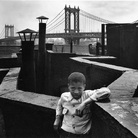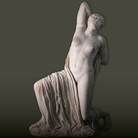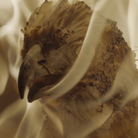Flora Commedia: Cai Guo-Qiang agli Uffizi

© Cai Studio / Ph. Yvonne Zhao | Cai Guo-Qiang, Renaissance Flower Garden, 2018. Gunpowder on canvas, 300x400 cm.
Dal 20 November 2018 al 17 February 2019
Firenze
Luogo: Gallerie degli Uffizi
Indirizzo: piazzale degli Uffizi
Curatori: Eike Schmidt, Laura Donati
E-Mail info: uffizimedia@beniculturali.it
Sito ufficiale: http://https://www.uffizi.it/
Le Gallerie degli Uffizi sono onorate di annunciare l’ultima mostra personale dell’artista contemporaneo Cai Guo-Qiang, Flora Commedia, che aprirà il 20 novembre 2018. La mostra è co-curata da Eike Schmidt, direttore degli Uffizi, con Laura Donati, curatore del Gabinetto dei Disegni e delle Stampe delle Gallerie degli Uffizi.
Il titolo della mostra trae ispirazione dalla Divina Commedia di Dante Alighieri. L'artista si appropria della flora del Rinascimento come soggetto, catturando lo spirito e l'anima del periodo; attraverso la rappresentazione dei fiori, Cai Guo-Qiang dipinge la natura, il cosmo e le emozioni personali. Per prepararsi all’esposizione, l’artista si è dedicato allo studio della tecnica della punta d’argento presso il Gabinetto dei Disegni e delle Stampe degli Uffizi e ha visitato più volte il Giardino mediceo di Boboli per osservare le diverse varietà di fiori del Rinascimento. La Limonaia, antica serra della famiglia Medici e luogo in cui oggi continua la coltivazione della flora rinascimentale, è stata una delle principali fonti di ispirazione. Cai Guo-Qiang ha anche lavorato a stretto contatto con gli esperti botanici degli Uffizi, ricreando varietà floreali del Rinascimento e riproducendole sulla tela.
La mostra sarà allestita nelle dieci gallerie connesse alle sale caravaggesche, del corpo principale degli Uffizi. Ogni galleria sarà dedicata a un tema specifico come il “Dialogo con Caravaggio”, il “Giardino del Rinascimento”, il “Giardino del Colore”, il “Giardino della Natura”, il “Giardino del Cosmo” e il “Giardino dell’Erotico”. Complessivamente, vi saranno esposte circa sessanta opere o gruppi di dipinti di varie dimensionirealizzati con polvere da sparo, oltre a una selezione di bozzetti dell’artista che ne illustrano il processo creativo. Le opere sono state realizzate in gran parte con tecniche originali sviluppate appositamente per la mostra, tra cui la tecnica della pittura tramite bastoncini d’incenso, ispirata alla collezione di disegni a punta d’argento degli Uffizi. Come spiega Cai Guo-Qiang: “Volevo purificare le cose questa volta, e concentrarmi principalmente sulla pittura dei "fiori"… il porre l’attenzione su un singolo tema mi ha portato a ulteriori considerazioni: cos’altro si può fare con la pittura? Come possiamo creare dei buoni dipinti attraverso i fiori? Come possiamo dipingere spontaneamente e con libero fervore, spingendo i dipinti a essere sempre più audaci? Diventare liberi e senza freni ancorando e centrando il cuore e la mente- queste considerazioni costituiscono sia il principio fondamentale che gli obiettivi. Una volta purificate le cose, diventa ancora più difficile evitare le difficoltà del dipingere!” Eike Schmidt, Direttore delle Gallerie degli Uffizi, aggiunge: “Il lavoro di Cai incarna la qualità esplosiva del processo creativo in una tachigrafiache si spinge all'estremo: fugace, istantaneo e, mentre osserviamo le tracce dei gesti e il movimento, necessariamente evocativo dei momenti già trascorsi. Alludendo a dipinti iconici del passato, queste immagini diventano metafore del loro improvviso e potente ritorno dalle profondità della memoria.”
Flora Commedia: Cai Guo-Qiang agli Uffiziè anche una continuazione critica del progetto di Cai “Viaggio di un Individuo attraverso la Storia dell’Arte Occidentale”,“An Individual’s Journey through Western Art History”, che è iniziata nel 2017 e include mostre personali in sei musei tra i più conosciuti al mondo, tra cui il Museo del Prado, il Museo Pushkin ed il Museo Archeologico Nazionale di Napoli (febbraio 2019). Ogni esposizione instaura un dialogo con i rispettivi aspetti della storia dell’arte occidentale rappresentati da ciascuna istituzione, con l'obiettivo comune di esplorare nuove possibilità nel mondo dell’arte. Come artista orientale del XXI secolo, Cai Guo-Qiang dipinge con l'espressione artistica, i metodi ed il temperamento di un artista contemporaneo nel suo proprio contesto, alla ricerca un dialogo significativo con lo spirito del Rinascimento.
La mostra sarà accompagnata da un catalogo (con edizioni in italiano, inglese e mandarino) che includerà saggi di Eike Schmidt, Direttore delle Gallerie degli Uffizi, del curatore Germano Celant, dello storico dell’arte Simon Schama, della co-curatrice di Flora CommediaLaura Donati e dell’artista stesso. Verrà girato un breve documentario diretto da Shanshan Xia, che rivelerà la perseveranza, la vulnerabilità, l’incertezza e l'autocritica dell'artista in questo viaggio di pittura.
La mostra è resa possibile dall’inestimabile supporto del Sig. e della Sig.ra Silas Chou e del Sig. e della Sig.ra Cheung Chung Kiu, e dai contributi speciali di Art Care Art Consultant co., Ltd. e della Shanghai International Culture Association.
Cai Guo-Qiang è nato nel 1957 nella città di Quanzhou in Cina. Ha studiato scenografia presso l'Accademia teatrale di Shanghai e da allora nel suo lavoro ha sperimentato diversi mezzi artistici, tra cui il disegno, l’installazione, il video e la performance. Mentre viveva in Giappone dal 1986 al 1995, ha esplorato con i suoi disegni le proprietà della polvere da sparo, una ricerca che col tempo l’ha portato allo sviluppo dei suoi caratteristici eventi pirotecnici. Attingendo alla filosofia orientale e alle questioni sociali contemporanee come basi concettuali, le sue opere d'arte rispondono direttamente alla cultura e alla storia locali e stabiliscono uno scambio tra gli spettatori e il vasto universo che li circonda. La sua personale arte pirotecnica e le sue installazioni sono piene di una vitalità e di una forza che trascendono il piano bidimensionale e si espandono dallo spazio del museo alla società e alla natura.
Cai Guo-Qiang è stato insignito del Leone d'oro alla 48esima Biennale di Venezia del 1999, del ventesimo Fukuoka Asian Culture Prize nel 2009, del Barnett e dell'Annalee Newman Foundation Award nel 2015 e del Bonnefanten Award for Contemporary Art (BACA) 2016. Nel 2012, è stato premiato con il prestigioso Praemium Imperiale, che riconosce i successi artistici raggiunti in vita all’interno di categorie non incluse nel Premio Nobel. Inoltre è stato anche tra i cinque artisti che hanno ricevuto la prima edizione del U.S. Department of State Medal of Arts Award per il suo eccezionale impegno nello scambio culturale internazionale. Cai è stato anche direttore degli effetti speciali e visivi per le cerimonie di apertura e chiusura delle Olimpiadi estive del 2008 a Pechino.
Tra le sue molteplici rassegne personali e mostre, si ricordano Cai Guo-Qiang on the Roof: Transparent Monumental Metropolitan Museum of Art di New York nel 2006 e la sua retrospettiva I Want to Believe, che ha aperto nel 2008 al Solomon R. Guggenheim Museum di New York. La sua prima mostra personale in Brasile, Da Vincis do Povo, ha attraversato il paese in tre diverse città nel 2013, viaggiando da Brasilia a San Paolo prima di raggiungere l’ultima tappa di Rio de Janeiro, ed è stata la mostra di un artista vivente più visitata al mondo in quell’anno con oltre un milione di visitatori. Nel giugno 2015 Cai ha creato lo spettacolo pirotecnico Sky Ladderal largo dell'isola di Huiyu a Quanzhou in Cina; l'opera è diventata il pezzo centrale del documentario di Netflix del 2016 Sky Ladder: the Art of Cai Guo-Qiang, diretto dal premio Oscar Kevin Macdonald.
Il suo più grande progetto artistico negli Stati Uniti dell’ultimo decennio, Cai Guo-Qiang: Fireflies, è stato avviato a Philadelphia nel settembre 2017. Nello stesso anno, è stato realizzato, in dicembre a Chicago, Color Mushroom Cloud, il suo più recente spettacolo pirotecnico. Nel 2017 le sue mostre personali sono state Cai Guo-Qiang: Octoberal Museo Pushkin di Mosca, e The Spirit of Painting. Cai Guo-Qiang al Pradopresso il Museo del Prado di Madrid.
Attualmente vive e lavora a New York.
SCARICA IL COMUNICATO IN PDF
COMMENTI

-
 Dal 2 December 2025 al 19 February 2026
Milano | Centro Culturale di Milano
Dal 2 December 2025 al 19 February 2026
Milano | Centro Culturale di Milano
Walter Rosenblum. Il mondo e la tenerezza
-
 Dal 30 November 2025 al 12 April 2026
Gallarate | Museo MA*GA
Dal 30 November 2025 al 12 April 2026
Gallarate | Museo MA*GA
Kandinsky e l’Italia
-
 Dal 29 November 2025 al 12 April 2026
Roma | Musei Capitolini
Dal 29 November 2025 al 12 April 2026
Roma | Musei Capitolini
La Grecia a Roma
-
 Dal 22 November 2025 al 3 May 2026
Torino | Sale Chiablese dei Musei Reali
Dal 22 November 2025 al 3 May 2026
Torino | Sale Chiablese dei Musei Reali
Orazio Gentileschi. Un pittore in viaggio
-
 Dal 20 November 2025 al 25 January 2026
Firenze | Palazzo Strozzi
Dal 20 November 2025 al 25 January 2026
Firenze | Palazzo Strozzi
Andro Eradze. Bones of Tomorrow
-
 Dal 21 November 2025 al 28 March 2026
Cuneo | Complesso Monumentale di San Francesco
Dal 21 November 2025 al 28 March 2026
Cuneo | Complesso Monumentale di San Francesco
La Galleria Borghese. Da Raffaello a Bernini. Storia di una collezione


